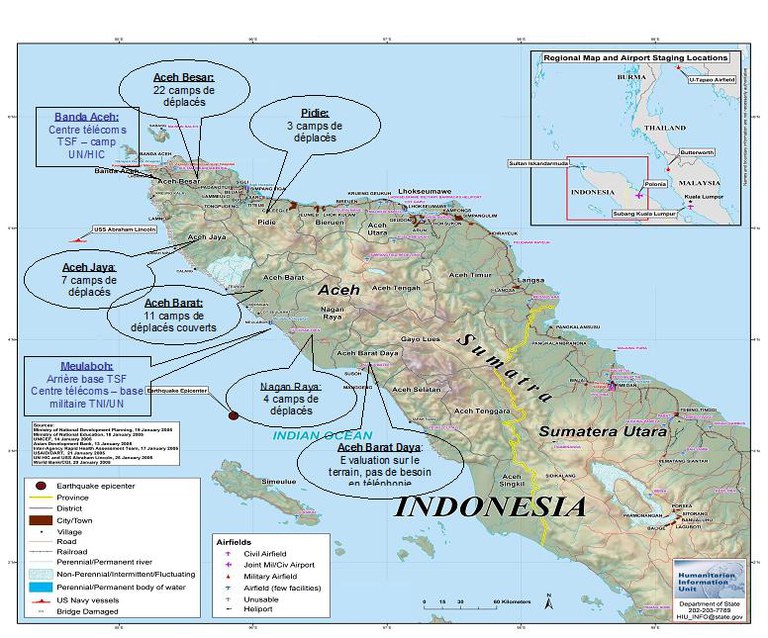Indian Ocean earthquake and tsunami
Context: Tsunami
Start date: 03/01/2005
End date: 15/02/2005
Areas of intervention: 6 departments in the Aceh province, Sumatra Island
- Aceh Barat Daya
- Aceh Barat
- Aceh Jaya
- Aceh Besar
- Pidie
- Nagan Raya
Activities:
- Telecoms centres
- Humanitarian calling operations
163 NGOs and institutions supported
3 406 families provided with calls
2 coordination centres set up
Context
On 26th December 2004, an earthquake measuring 8.9 on the Richter scale was recorded in the Indian Ocean, 250 km from the town of Banda Aceh on Sumatra in Indonesia. The intensity of the earthquake caused a tidal wave with waves over ten meters sweeping the northwestern coast of Sumatra, the south and east coast of Sri Lanka, the west coast of Thailand.
This powerful tsunami was felt on the African continent, affecting eight countries in its path: the Seychelles, Somalia, the Maldives, India, Myanmar, Sri Lanka, Malaysia, Thailand and Indonesia, causing approximately a total of 276,000 deaths, injuring 14,000 people and displacing 200,000. All families suffered enormous loss of life and property.
The Indonesian island of Sumatra was the most affected area with over 101,199 people dead, 2,748 wounded, 127,774 missing and 417,124 displaced. More than three quarters of all deaths occurred in this province. Six out of 21 districts suffered total or partial destruction of the telecommunications network.
Deployment
Télécoms Sans Frontières deployed to Sri Lanka with a flight organised by the French Ministry of Foreign Affairs the day after the disaster. The Indonesian government appealed for international aid five days later, announcing an immeasurable emergency.
Mobilised in Thailand and Sri Lanka, upon obtaining authorizations from the Indonesian government, under the financing of the European Civil Protection and Humanitarian Aid Operations (ECHO), a team deployed to the Aceh region to provide means of communication. The provisions of satellite telecommunications services for relief organizations and for the affected population was a priority.
Telecoms centres
TSF installed satellite telephone lines and faxes for local authorities and emergency actors in the coordination centres of two affected districts.
On January 3, TSF joined the United Nations Humanitarian Information Center in Banda Aceh. TSF immediately installed a local and international telecommunications centre, the only installation offering Internet every day from 7am to 11pm. This hub was the focal point for all humanitarian aid on the zone until 24th January.
On January 8, a second centre in Meulaboh was opened by TSF at the NGO Coordination Centre, first located in a school and then transferred to an office of the Indonesian Army Camp (TNI). Until 07 February, TSF had taken a leading role in the organisation of relief in Meulaboh through its telecom centre. Indeed, in the first week following the installation of TSF in Meulaboh, no means of communication other than satellite was available. In addition to coordinating relief efforts, the Meulaboh telecom centre also allowed NGOs to follow their security plan, which usually included one or two calls per day to their base in Banda Aceh.
TSF ceased operations in the Aceh region on February 15 when the emergency phase was over. Organisations could now benefit from different telecom services that were available.
Humanitarian calling operations
TSF focused its humanitarian calling activities on the six most affected districts with a total of 289,493 refugees.
The population was in shock, many spontaneous displacement camps had been created in the province of Aceh. It was very difficult to obtain reliable information on the whereabouts of the displaced, who regularly changed camps or found refuge with family or friends.
Operations were conducted in 47 camps to facilitate family reunification and provide vital psychological relief throughout the first emergency phase.
Four weeks after the disaster, the need for telecommunications had decreased. People were already in a phase of rehabilitation and many of them had already managed to contact relatives or families. It was difficult to identify all the remaining small camps scattered throughout the city, so TSF worked in collaboration with the ICRC / PMI which offered a message and letter service for families that had been separated.






















